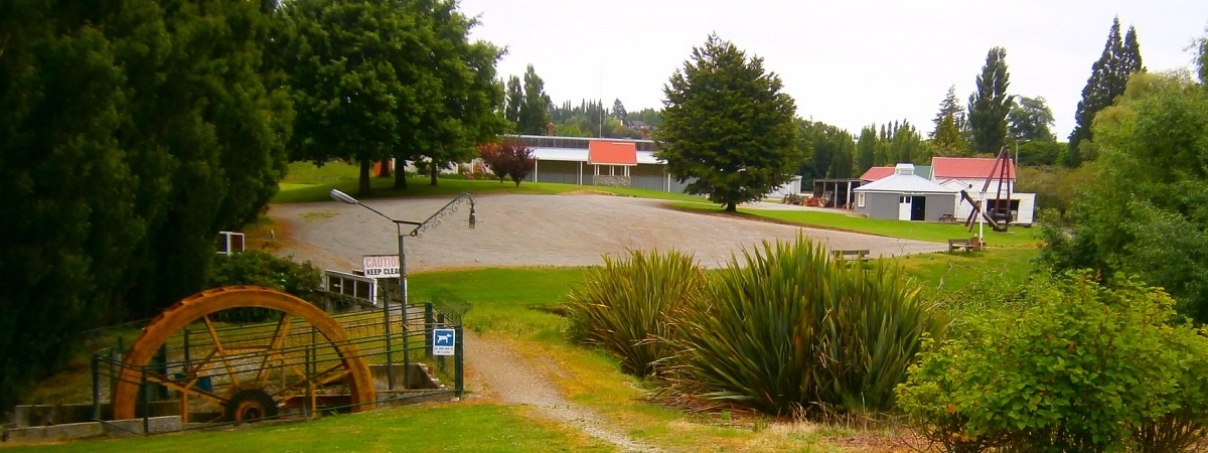
The Main Pavilion
This is the main entry to the park for visitors. Here visitor information is available.
Inside this building there are toilets, office and kitchen and space to walk around the exhibits.
The pavilion contains an extensive display of vintage farm tractors, machinery and implements.
Included are collections of communication equipment from the past, tradesmen's tools and household appliances. The exhibits are in the same condition as they were when in daily use. Many await restoration.
After a number of major fundraising ventures the building was let out to tender and completed construction in 1997. As a contribution to Mr. Ray Tressler (a Foundation Member) this was named after him as with his building trade behind him and the many volunteer hours and working bees it would not be as it is today. The building was originally built without a concrete floor but it allowed members to offer the public a site to view what is here today. Through the sheer perseverance of Mr. Paisley Laird, Mr. Herbie Horrell and team, section by section was concreted as it is today.
The Mandeville Anglican Church
The church was gifted to the park and was moved to the site in 1979.
Extensive work was required to move and re-assemble the building on site and complete the painting. More work was needed to restore the fittings on this beautiful building.
The church was originally built from rimu (a native timber) timber, in 1883 at a cost of 160 pounds. It was named "The church of Epiphany." From the opening day until closing day on July 1980, there were only four secretaries, remarkably, all from the same family.
In 2012, the church was privileged to have a new stained glass window installed in the north wall. It was donated by the Horace Hugh Horrell families and had been removed from the St Phillips Anglican Church of Waikaka on its closure.
The church is available for hire for weddings.
It can seat up to 60 guests.
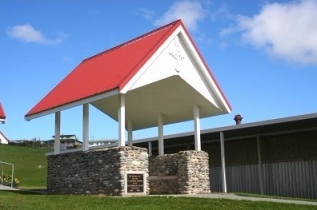


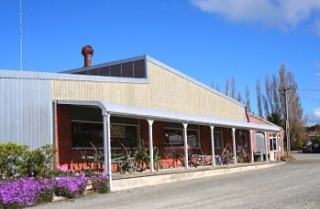
The Old Balfour Bank
This building shifted from the Balfour Agency to this site in 1978, after it officially closed.
The original bank was opened in Balfour (an area in Northern Southland) in 1910. The manager arrived in Balfour driven in a gig with an armed escort. He rode a horse around the local agencies.
The agency closed in 1942 - due to World War 2. It re-opened in 1946, but only for an hour on Thursdays.
Pioneer Cottage
This cottage was moved 500 metres to the Park from its original address, 237 Main Street, Jacobstown, in July 1977. Jacobstown was the original name of the northernmost area of Gore.
Built in 1883, the cottage represents the type of dwelling commonly erected by people of humble means. Nonetheless, these sturdy homes gave people a feeling of independence and pride in their homes. The front and back doors are of a very old type and came from the Presbyterian manse, Devon Street, Gore.

The Ferndale School
Originally from Ferndale (South-east of Gore) the school was built in 1884. It was in use for daily schooling up until 1965. It was then used as the local hall until 1983. It arrived on site at the park in 1986.
The interior is also original. Displayed is typical educational paraphernalia of the times - old pens, books, slates, exercise books and sports gear etc.
The old piano was typical of the times. Heating was by the old pot-bellied stove.
The Blacksmith Shop
A 'Smithy' was part of every early settlement in Southland.
They were essential for building and servicing implements in the early era of horse power. Horses were also shod.
The building was completed in 1992 to complement the other buildings and to display memorabilia.
It is a functional building. The forge can be fired up for use.
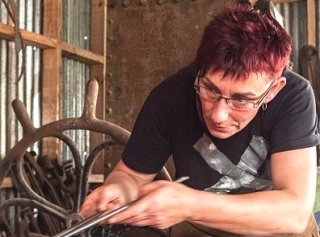
The Open Shed
This shed is on the left as you enter the complex. It houses a number of wooden drays that were used for much of the farm work in the early years.
The Reid and Grey wagon, owned by the Gardyne family is on permanent loan to HPP. It was fully restored in 2003. It is painted in its original colours.
Over 400 hours of volunteer help went into this project.
Proposed future work is to build a veranda to display harness and other stable items.
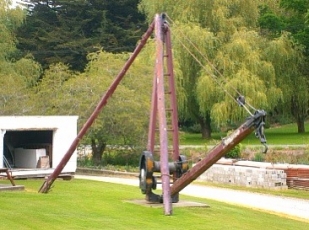
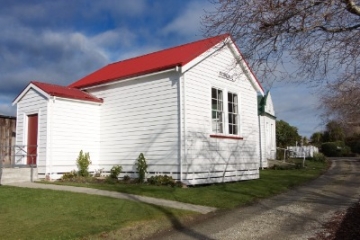


Main Attractions in the Park

The Kingston Crane
The crane was built in the 1880s, in Dunedin. The main spar was made from Australian hardwood. The crane crane was then transported by train to the jetty at Kingston, at the southern end of Lake Wakatipu. It was used to lift goods onto and off the steamers, including the 'Earnslaw' for the N.Z. Railways.
Early last century, the steamboat trade decline and the branch line was closed in 1979. The crane was blown into the lake by a storm. For many years it lay on the bottom of the lake.
After the formation of Hokonui Pioneer Park the members began collecting many of the exhibits which would go on show in the future.
Most of the exhibits inside have been donated to HPP or on long term loan. Many are irreplaceable and all were sourced from the local farming area of Eastern, Northern and Southern Southland before they were lost to the district.
A large collection of tractors, horse drawn implements and farm maintenance items along with stationary engines are on display. For the women there is also a vast selection of domestic exhibits from washing and sewing machines, vacuum cleaners and other household appliances. A number of business machines and communication exhibits along with the Newman Saddler and Thompson Boot Maker displays are also there. In the future we hope to set up a funeral parlour as well as the Lampson money transfer unit from local H & J Smiths store.
Hokonui Pioneer Park extended the original north wall from the building of the Gore Vintage Car Club section. This part houses the 1931 Fire Engine and a selection of vintage cars of the GVCC members.
Just inside on entry to the right of the doorway is a local 1931 Merryweather Fire Engine. Based in Gore all its life and used by the local brigade it is owned by the Gore District Council and still holds regular road worthy certificates if needed for use should an occasion arise.
At the rear of the pavilion is a 1904 Burrell Traction engine, fully restored and road worthy. It has lived all its life in the Southland area. It was saved from being shipped overseas by a grant to HPP from the Internal Affairs.
The side wall of the pavilion under the verandah holds a selection of plaques. Most are self explanatory but evolved when the old Gore Hospital was demolished – the memorial stones and tree plaques being donated to HPP. This area will be continually added to. There is a selection of implements on the verandah and these continue around to the north side undercover.
Members are continually making exhibits into interactive displays. We regularly participate in local street parades and events to promote our village. We have a themed open day annually. Exhibits are operating and working where possible.
The Lychgate
This is located close to the church, but not connected to the church.
It was built in 2000 as a replacement memorial for the now demolished Rest Rooms in Gore, originally built by the WDFF and Country Women of Eastern Southland.
The construction is of Mataura River and Otamita River stones.
A lychgate is a roofed gateway to a church. It was formerly used for funerals. It sheltered a coffin outside the church in inclement weather until the clergyman arrived.
Today, this lychgate stands as a tribute by present women to those of the past and is dedicated to those future women of Eastern Southland.
This was one of New Zealand's smallest bank buildings. It has the original counter and the early ledgers from Dalgety's on display.
These show the names of district identities, their lands and their loans. Nothing computerised. The currency is recorded in the Imperial Pounds, Shillings and Pence.
The two-roomed structure contains the front office and the rear living room - the travelling bank manager slept here overnight, guarding his money with a revolver that he kept under his pillow.
On the closing of the bank this building was used by the Plunket Nurse (a baby medical home service) during her fortnightly visits, until new Plunket rooms were built.
For many Balfour families, the infant scales are part of the history for this building. Not many banks had scales that were used for weighing babies!
A typical period cash register has been set up on the main desk. You can see a variety of stationery equipment on the main counter.
The interior has been refurbished in 2015 with fresh paint. The desks have come from a variety of sources.
The Play Shed
The open play shed provided pupils with a place to play when the weather was inclement. This shed arrived from the Ferndale school at the same time as the school building.
The relocation and restoration and displaying of the authentic exhibits in this cottage was the initiative of the late Win Hamilton and the Gore District Historical Society as their major contribution to the Park.
The Hokonui Pioneer Park conferred Life Membership to Win in 1994.
The cottage was opened in April 1979. Each room is fully functional as it originally was, including the outside shrubs and plants.
An inventory of memorabilia is available inside as you tour the cottage.
The Douglas hand water pump on the lawn was donated by the late Paisley Laird in February, 2003
The chosen name is 'McNab Smithy,' to commemorate the first run holder in the area and also as a result of a generous donation made by the now-defunct McNab Hall Committee.
In the 1960s, members of the Gore Boat Club and the Gore Diving Club recovered the crane. After much work it was fully restored.
It is capable of lifting 7 tons, all without an engine. It was winched by hand by two men.
Initially it was used in Gore to lift implements for a local blacksmith works.
When these works closed, the crane was purchased by another local company. From there it was donated to the park. It was fully restored in 2002.